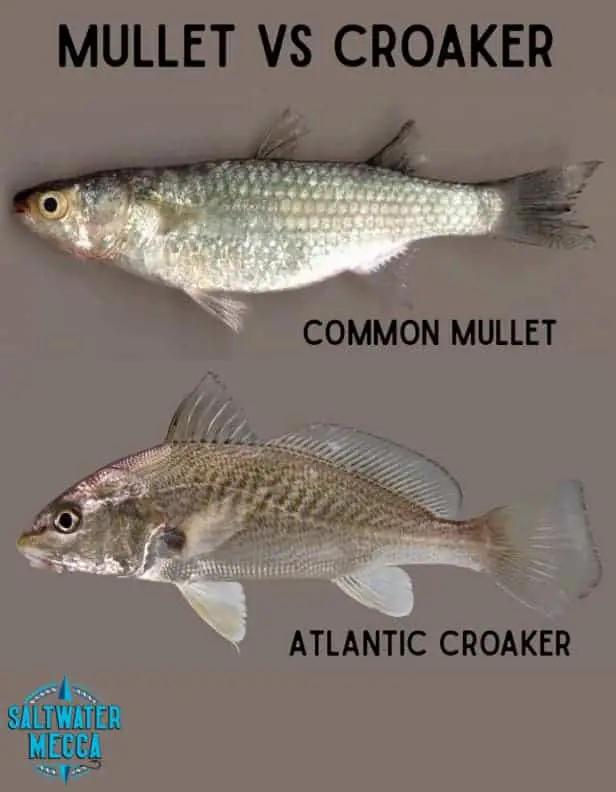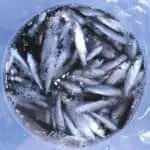Have you ever wondered the difference between mullet vs croaker? These two terms are often used interchangeably, and incorrectly by fishermen all over the world.
What is the difference? And why the confusion?
Mullet and croaker are two totally different fish, from different families. However, due to a similar appearance and some overlapping colloquial names for these species, there’s some real confusion.
Table of Contents
- What Is The Difference Between Mullet And Croaker?
- Is Sea Mullet A Croaker?
- Why The Confusion?
- Which Makes Better Bait?
- What Fish Is Similar To Croaker?
- Related Posts
What Is The Difference Between Mullet And Croaker?

Mullet
There are eighty species of true mullet, but all are members of the Mugiliformes taxonomic Order. Mullet have a long body with two distinct dorsal fins and a small, triangular mouth with large lips. They can commonly reach over two feet and weigh between two and three pounds.
Mullet are common in temperate and tropical coastal waters and do not limit themselves to saltwater, swimming into and living in coastal rivers and creeks. They are mainly bottom feeders, subsisting on algae and vegetation.
Mullet have a long history as a popular food source, as well as being a very common fish used for bait.
One of the best-known behaviors of mullet is that they are enthusiastic and frequent jumpers. No one is really sure why they do this, but some think that the jumping somehow raises their blood/oxygen levels.
Croaker
Croakers are a group of fish in the family Sciaenidae of the order Perciformes. Sciaenidae are commonly referred to as croakers or drums.
This family can include such seemingly different species as Atlantic croakers, spotted and silver sea trout, drum, perch, and kingfish, along with many more.
The distinguishing characteristic of this family is the ability to make a croaking or drumming noise. This is done by vibrating special muscles in the fish’s abdomen against the swim bladder.
The croaking serves different purposes in different species. For some it’s a mating call, some use it as a territorial warning, and some even seem to use it to communicate in muddy water.
Hunting bottlenose dolphins have actually learned to hone in on the croaking noise made by some of the more vocal species!
Croakers are found in temperate and tropical coastal waters, including freshwater, and are a largely carnivorous, bottom-feeding family.
Is Sea Mullet A Croaker?
Confusingly enough, sea mullet is a croaker, but isn’t a mullet!
Sea mullet is a colloquial name most commonly used to refer to three species of kingfish (also known as whiting), which are members of the Sciaenidae family, not Mugiliformes like true mullet. These are the southern, northern, and Gulf kingfish.
Like other croakers, kingfish are bottom-feeding predators, in contrast to true mullets which eat detritus.
These fish can be known as kingfish, sea mullets, whiting, and Virginia mullet, together with several other less common names in various localities and regions.
You May Also Like: Mullet vs Whiting; What Exactly Is The Difference?
Darn fisherman always coming up with nicknames!
Why The Confusion?
The confusion is most likely the result of a superficial resemblance between the kingfish and the mullet species. Both have a similar body shape and both are mostly bottom-dwelling.
Mullet and kingfish also have similarly shaped heads, with small jaws on the bottom of the head. This, combined with their sometimes silvery color pattern explains why they might be confused.
A kingfish looks a lot more like a mullet than it does like the sea trout that it’s actually related to!
Once it started to be known colloquially as a sea mullet, the confusion just got worse.
And, once a croaker, like the kingfish, became known as a mullet, it got even easier to confuse some of the other non-trout croakers with mullet!
Which Makes Better Bait?
This totally depends on what you’re fishing for and when and where you’re doing it. As is almost always true of fishing, if your bait matches what the fish are eating day in and day out, you will do better. Knowing what food is in the water should be your starting point.
One big advantage of mullet is that they are hardier and are easier to keep alive in your livewell or bucket over a full day of fishing. Its also much easier to cast net for live mullet , which usually do not have a size or bag limit.
The specific fish you are fishing for also may make a difference. It’s a common belief that live croakers are far and away the best bait for sea trout and snook, to the point where some people even argue that the use of croakers is unfair and damaging to the trout population.
The answers to which is better bait are all over the place, probably because it can be different depending on where, when, and for what you are fishing for.
I personally think croakers are a bit over-rated, and they are very expensive from bait shops. In my area, they cost as much as $3 per fish!
See Also: Using Mullet For Shark Bait? Follow These Tips!
What Fish Is Similar To Croaker?
Other fish species that are similar to croakers are:
- Silver Trout (Cynoscion nothus)
- Red Drum (Sciaenops ocellatus)
- Black Drum (Pogonias cromis)
- Spot (Leiostomus xanthurus)
- Weakfish (Cynoscion regalis)
Are Whiting And Croaker The Same?
Whiting and are croakers are not the same species of fish, although they are often confused by anglers because they inhabit similar habitats.
Both whiting and croakers are common catches, especially by surf anglers who fish along warm coastal waters of the Gulf of Mexico and Atlantic oceans.

Growing up in Florida, I’ve been surrounded by saltwater my entire life…and I love sharing my passion with others.
To learn more about why I started Saltwater Mecca, visit the ABOUT page.
Thank you for reading this article. Browse around & have some fun!





